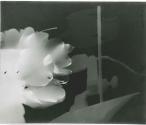Untitled
Artist: Man Ray (American, 1890-1976)
Date: about 1927
Dimensions:
Overall: 11 15/16 x 10 in. (30.4 x 25.4 cm)
Medium: Rayograph
Classification: Photographs
Credit Line: Purchased with funds from the Libbey Endowment, Gift of Edward Drummond Libbey
Object number: 1993.77
Label Text:Man Ray, a central figure in New York Dada, moved to Paris in 1921. In 1922, he reinvented the old technique of the photogram, which he dubbed "Rayographs." To a patron, he described using "photographic materials without the camera: objects found or forms constructed by myself intercepting arranged lights that are thrown on sensitive paper. Each work is an original." Called "pure Dada creations," these cameraless works subvert the expectation of the medium's factuality to create a poetic vision of things, one rich in allusion and mystery.
Photographer, painter, sculptor, and filmmaker Man Ray was a central figure in New York Dada, an avant-garde art and literary movement that celebrated the absurd and rejected the “reason” of capitalist society. In 1922, Man Ray reinvented the old technique of the photogram, which he dubbed "Rayographs." To a patron, he described using "photographic materials without the camera: objects found or forms constructed by myself intercepting arranged lights that are thrown on [light] sensitive paper. Each work is an original." Called "pure Dada creations," these cameraless works subvert the expectation of the factual nature of photography to create a poetic vision of things, one rich in allusion and mystery.
Man Ray and Solarization
One of Man Ray’s major contributions to photography was his experimentation with edge reversal (Sabattier effect), a phenomenon similar to overexposing an image, which photographers call “solarization.”
This process, which Man Ray kept secret until 1933 when an associate revealed it, produces a sense of disembodiment in images by introducing light during developing. When a sensitive emulsion that has been developed but not fixed is exposed to light and developed again, the image shows a reversal of tones wherever there is a sharp edge. Because a print from such a negative has its contours rimmed with black lines, it incorporates graphic effects without any manual intervention. The effects, which are often subject to chance, are based on the length of exposure time. In addition to this two-dimensional enhancement, solarization also permitted Man Ray to accentuate form by bringing to the work a new sense of three-dimensionality.
Photographer, painter, sculptor, and filmmaker Man Ray was a central figure in New York Dada, an avant-garde art and literary movement that celebrated the absurd and rejected the “reason” of capitalist society. In 1922, Man Ray reinvented the old technique of the photogram, which he dubbed "Rayographs." To a patron, he described using "photographic materials without the camera: objects found or forms constructed by myself intercepting arranged lights that are thrown on [light] sensitive paper. Each work is an original." Called "pure Dada creations," these cameraless works subvert the expectation of the factual nature of photography to create a poetic vision of things, one rich in allusion and mystery.
Man Ray and Solarization
One of Man Ray’s major contributions to photography was his experimentation with edge reversal (Sabattier effect), a phenomenon similar to overexposing an image, which photographers call “solarization.”
This process, which Man Ray kept secret until 1933 when an associate revealed it, produces a sense of disembodiment in images by introducing light during developing. When a sensitive emulsion that has been developed but not fixed is exposed to light and developed again, the image shows a reversal of tones wherever there is a sharp edge. Because a print from such a negative has its contours rimmed with black lines, it incorporates graphic effects without any manual intervention. The effects, which are often subject to chance, are based on the length of exposure time. In addition to this two-dimensional enhancement, solarization also permitted Man Ray to accentuate form by bringing to the work a new sense of three-dimensionality.
Not on view
In Collection(s)




